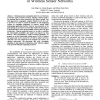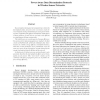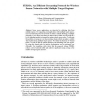346 search results - page 55 / 70 » Redundant Coverage in Wireless Sensor Networks |
ICC
2007
IEEE
14 years 2 months ago
2007
IEEE
—Slepian-Wolf coding is a promising distributed source coding technique that can completely remove the data redundancy caused by the spatially correlated observations in wireless...
GLOBECOM
2006
IEEE
14 years 2 months ago
2006
IEEE
— Reducing energy consumption has been a recent focus of wireless sensor network research. Topology control explores the potential that a dense network has for energy savings. On...
IPPS
2006
IEEE
14 years 2 months ago
2006
IEEE
Recent rapid technological developments have led to the development of tiny, low-power, low-cost sensors. Such devices integrate sensing, limited data processing and communication...
DCOSS
2010
Springer
14 years 23 days ago
2010
Springer
Abstract. We consider the problem of multihop broadcast over adaptively duty-cycled wireless sensor networks (WSNs) where neighborhood nodes are not simultaneously awake. We presen...
EUC
2005
Springer
14 years 1 months ago
2005
Springer
Some sensor applications are interested in collecting data from multiple regions. For supporting such applications with multiple target regions, most conventional protocols are bas...



